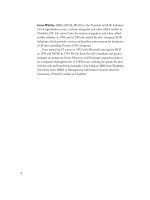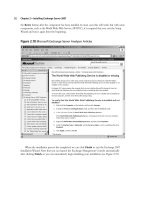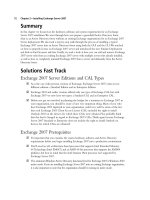Exchange SQL And IIS- P139 ppt
Bạn đang xem bản rút gọn của tài liệu. Xem và tải ngay bản đầy đủ của tài liệu tại đây (278.15 KB, 5 trang )
Introduction to Exchange Server 2007 Unifi ed Messaging • Chapter 11 667
The Unifi ed Messaging Infrastructure
Because the Unifi ed Messaging component of Exchange Server 2007 connects with telephony and
fax systems, you should be familiar with basic telephony concepts and terminology.
■
Private Branch eXchange (PBX) A PBX is a device that acts as a switch for
switching telephony calls. This device is used to provide internal telephone connections
and offer access to telephone numbers through shared outside lines to make calls exter-
nal to the company. Additional communication devices can be connected to a PBX
besides telephones—such as fax machines, voice mail systems, and others. Calls from
outside the company are transferred to the appropriate extension or forwarded by a
human operator.
■
IP-PBX An IP-PBX is a PBX that operates with Internet Protocol (IP). This
simplifi es the infrastructure because telephones can be connected to the same local
area network (LAN) as the computers and servers. The IP-PBX switches calls to the
appropriate phone by using the IP address of the telephone. For using IP-based
telephony, all telephones must support the IP protocol. A hybrid IP-PBX supports IP
phones, but is also able to connect traditional analog and digital telephones.
■
Voice over Internet Protocol (VoIP) This technology enables the use of IP-based
networks as the infrastructure for telephone calls.
■
IP or VoIP gateway IP/VoIP gateways are hardware devices that can be used to connect
legacy PBX systems to local area networks to provide IP-based telephony services. These
gateways convert the legacy protocols from the PBX to VoIP-based protocols like SIP and
RTP. For an up-to-date list of supported gateways, see the link in the shortcut area of this
section.
■
Dial plan The dial plan is a set of rules that is used by the PBX to determine
which action to take when it receives a call. For example, a 0 is often used to get to
the public telephone network. When the fi rst number is not a 0, the PBX knows
it will be an internal call, but then needs to know how many more numbers to wait
for before taking action. Within the Unifi ed Messaging server, the dial plan creates a link
between an Exchange Server 2007 recipient’s phone extension in the Active Directory and
the recipient’s Unifi ed Messaging–enabled mailbox. After a dial plan is confi gured, a Unifi ed
Messaging server must be added to the plan. This links the dial plan and the server and
enables the server to accept and handle incoming calls.
668 Chapter 11 • Introduction to Exchange Server 2007 Unifi ed Messaging
■
Hunt group A hunt group is a set of extensions shared by users. When a PBX receives
a call for a number that is assigned to a hunt group, it searches through the connected
extensions to fi nd an available phone. Hunt groups are often used to distribute calls among
members of support or sales departments. Customers call one number for the support team,
and the call could be routed to any member of the team who is not currently on the
phone. Within the Unifi ed Messaging confi guration, a hunt group is a logical representation
of an existing PBX or IP-PBX hunt group. This provides Unifi ed Messaging possibilities for
the pilot number (shared telephone number of the hunt group).
An Exchange 2007 Unifi ed Messaging component connects with the existing telephony
infrastructure to create a Unifi ed Messaging infrastructure. Figure 11.3 shows an example of a
Unifi ed Messaging infrastructure.
Figure 11.3 Unifi ed Messaging Infrastructure
PBX
VoIP Gateway
UM Server
Client Access Server
Mailbox Server
Hub Transport Server
Domain Controller
Protocols
SIP : Manage Session
RTP : Transmit Voice Data
T.38 : Transmit Fax Data
This Unifi ed Messaging infrastructure consists of the following components:
■
PBX and connected phones The PBX is connected to the external telephone system
using one or more lines. The telephones are directly connected to the PBX system.
Incoming calls are routed by the PBX to the appropriate phone.
Introduction to Exchange Server 2007 Unifi ed Messaging • Chapter 11 669
■
VoIP gateway The PBX system is attached to the VoIP gateway. The VoIP gateway,
meanwhile, is connected to the PBX with a fi xed number of ports; this depends on the
gateway’s capabilities. Whenever there’s no answer or a “do not disturb” signal on a user’s
phone, the call is routed to the VoIP gateway with information about the destination phone
number and the ID of the caller. The PBX also forwards calls made to specifi c telephone
numbers—for example, when users call the telephone number to access the Automated
Attendant services on the Unifi ed Messaging server. When using an IP-PBX, it’s not always
necessary to use a VoIP or IP gateway. Figure 11.4 shows the wizard that confi gures the
connection between the Unifi ed Messaging server and the VoIP gateway.
■
Exchange 2007 Unifi ed Messaging server The VoIP gateway is attached to the server.
This Unifi ed Messaging server takes calls from the IP gateway and handles the requests. The
Unifi ed Messaging server uses the SIP protocol and listens for requests on the default SIP
port 5060 tcp. For speech processing, the server depends on the Microsoft Speech Server
(MSS) component. This component is installed as part of the Unifi ed Messaging role and
runs as the MS Exchange Speech Engine service.
■
Domain controllers The domain controllers provide directory information, enabling the
Unifi ed Messaging server to route the incoming calls. Within the directory, all the Unifi ed
Messaging–enabled users have a phone extension number attribute. This attribute is used by
the Unifi ed Messaging server to fi nd the appropriate user and route the message to their
mailbox.
Figure 11.4 UM IP Gateway Wizard
670 Chapter 11 • Introduction to Exchange Server 2007 Unifi ed Messaging
The Unifi ed Messaging server uses three IP protocols for Unifi ed Messaging communications:
■
(SIP) Session Initiation Protocol SIP is a real-time signaling protocol and is used to
maintain the communication session. TLS can be used to secure the SIP traffi c. Exchange
Server 2007 Unifi ed Messaging uses only SIP over tcp.
■
(RTP) Real-Time Transport Protocol RTP is the protocol used for the transport
of voice traffi c between the VoIP gateway and the Unifi ed Messaging server. RTP
provides high-quality, streaming voice connections. RTP traffi c can also be secured by
using TLS.
■
T.38 (Real-Time Facsimile) This protocol is the fax transport protocol used by the
Unifi ed Messaging server. The Unifi ed Messaging server assumes that all incoming calls
are voice, so a fax call originates as a voice call using the RTP protocol. When the
Exchange Unifi ed Messaging server detects the fax tone, the call is switched to the T.38
protocol.
BEST PRACTICES ACCORDING TO MICROSOFT
Obtain assistance of a Unifi ed Messaging specialist to make sure there is a
smooth transition to Exchange 2007 Unifi ed Messaging from a legacy voice
mail system.
SOME INDEPENDENT ADVICE
If you are thinking about replacing your current PBX, take a look at systems that can
be directly connected to Exchange 2007 Unifi ed Messaging. One of the few is Cisco
Call Manager 5.x. Using a system that can be directly connected eliminates the need
for an extra gateway device.
NOTE
For information on IP-PBX and PBX support to />library/aa996831.aspx. For information on IP/VOIP gateway support, visit
To fi nd Unifi ed Messaging
partners, go to .
Introduction to Exchange Server 2007 Unifi ed Messaging • Chapter 11 671
The Unifi ed Messaging Mailbox Policies
When a new Exchange 2007 recipient is created, it is not UM-enabled. Once you enable a user
for Unifi ed Messaging, you can manage, modify, and confi gure the UM-related properties for the
user. You can then view and modify UM-related settings such as the associated UM dial plan,
the associated UM mailbox policy, and the extension number for the user.
UM-related settings are stored for a user in two places: the recipient’s mailbox and the user’s
Active Directory object. When you enable a recipient for Unifi ed Messaging, you are setting a
specifi c property on the user’s mailbox.
Using Unifi ed Messaging mailbox policies enables you to apply and standardize Unifi ed Messaging
confi guration settings for Unifi ed Messaging–enabled users. You can create Unifi ed Messaging mailbox
policies and then add the policy to a collection of Unifi ed Messaging–enabled mailboxes to apply a
common set of policies or security settings. Unifi ed Messaging mailbox policies are required before
you can enable users for Unifi ed Messaging.
The default Unifi ed Messaging mailbox policy is generated when you create the fi rst dial plan,
but you can establish additional mailbox policies based on your business’s needs. With a Unifi ed
Messaging mailbox policy, you can confi gure the following settings:
■
Dial plan (required)
■
Maximum greeting length
■
Number of unsuccessful login attempts before the password is reset
■
Minimum number of digits required in a PIN
■
Number of days until a new PIN is required
■
Number of previous passwords disallowed
■
Restrictions on international calling
Figure 11.5 shows the General tab of a Unifi ed Messaging mailbox policy.









